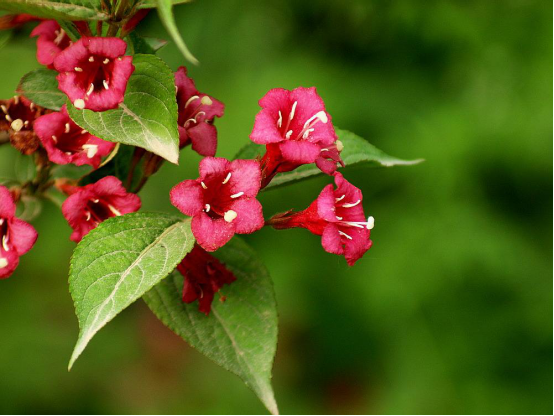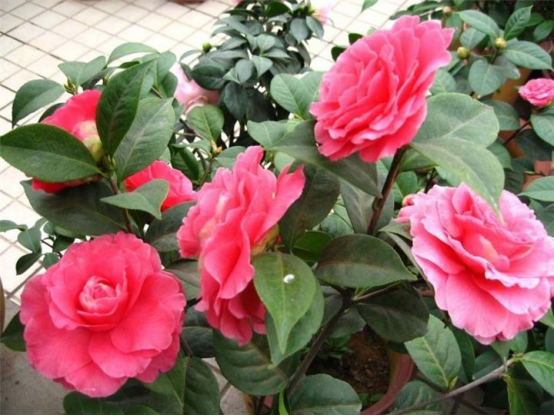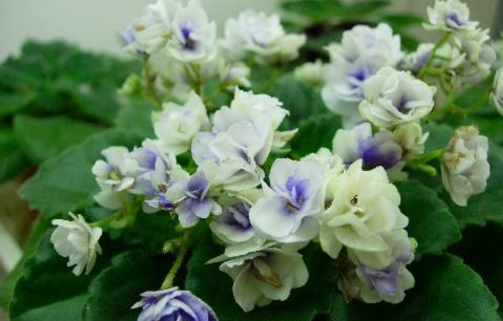Four Propagation methods of Brocade
one。 Cuttage
When planting variant types of brocade flowers, we usually use cuttings. In summer, the ungerminated branches of 1-2 years old were cut into branches with a length of about 13cm as cuttings, then the cuttings were dipped in the solution of a-naphthylacetic acid 2000mg/kg, and the cuttings were submerged into about half of the soil, then watered, and then as long as the soil was kept moist.
If you plant brocade flowers in the rainy season, use tender branches, which need to be cut to about 16cm length. It should be noted that the cuttings should be disinfected before cutting. at the same time, we should also pay attention to the drainage of potted plants to avoid the death of plants caused by stagnant water in potted soil.
two。 Sowing seeds
The first is seed collection, which is generally harvested from September to October. After harvest, the capsule is dried and crushed. After air selection, pure seeds can be obtained. The second step is seed treatment, commonly known as sprouting. Soak the seeds in cold water for 2-3 hours a week before sowing, then remove them and put them in the room to accelerate germination. If the seeds are wrapped in wet cloth and sowed, the effect will be better. It should be noted that the sowing should be carried out without wind or rainstorm in the near future, and the bed surface should be smooth and fine. Finally, we should not forget the seedling management, when the seedlings grow three to four fibrous roots, we can carry out the first seedling, and then remember to loosen the soil and weed in time.

three。 Pressing strip
The pressing usually chooses the strong branches in the lower part of the flower body and removes its outer skin, because the lower branches are easy to be creeping and the nodes are easier to take root and survive.
four。 Ramet
Ramets are generally combined with transplanting around spring. As the name implies, ramet is to dig up the whole plant, divide it into several clumps, and raise each separate clump separately.
Having seen the four breeding methods of brocade flowers above, are you now full of confidence in growing beautiful brocade flowers? Then go and try it!
How to propagate brocade flower the propagation method of brocade flower
Have you ever seen brocade flowers? Brocade is a common flowering shrub in the north. Brocade has strong adaptability and low requirements for soil, so it is relatively easy to grow. Next, let's take a look at the breeding method of brocade flower.
1. The propagation of brocade flower-cutting
In summer, you can cut off part of the branches of the brocade flower, insert half of the branches into the soil, then water thoroughly, and keep the soil moist. During the rainy season, part of the twigs can be cut, and the survival rate of cuttings is higher at this time. In spring, hardwood cuttings can be used to cut off the brocade flowers around 15cm and insert them into the prepared seedbed, or cut them in the open field with annual branches, which is easier to survive.
2. The propagation of brocade flower-- pressing.
Striping can be done at any time, generally pressing the branches under the flowers, the branches are close to the soil, easy to become creeping, and the branches are easy to take root at the nodes.
3. Propagation of brocade flower-ramet
The good season of ramet is mainly in autumn, winter and early spring. Dig out the whole plant and plant the ramet. In spring, one-year-old mature branches can be cut in the open field, or in summer, twigs of brocade flowers can be cut in the shade or under the shade. Remember, if you transplant brocade flowers, you should take lodging soil in spring and autumn and earth balls in summer, so that it is easier to survive.
4. Propagation of brocade flower-- sowing
If sowing, it should be carried out in mid-early April. After sowing, the soil should be often watered to keep the soil moist. Do not spray water with a spray can, it will spray the seeds out of the ground, and there will be no way to grow seedlings. The seedlings emerged about 15 days after sowing. Brocade grows slowly and generally does not use sowing method.
Introduction and Culture methods of Brocade Flower
The leaves of brocade flowers are oval or oval, the flower shape is very beautiful, has a high ornamental value, is often planted in gardens, backyards and other places, with the role of beautifying the environment. It also has a high value in the market, loved by many flower lovers, and often as the darling of artists, thus appearing in all kinds of literary works. Let's take a look at the knowledge of brocade flowers.
First, the introduction of brocade flowers
Brocade flower is a shrub, 3 meters high, 3 meters wide, branches spread, the tree shape is more cylindrical, some branches will bend to the ground, branchlets are thin and weak, with 2 rows of pilose when young. Leaves elliptic or ovate-elliptic, 5-10cm long, terminal acute, base rounded to cuneate, margin serrate, hairy on surface veins, especially dense abaxially. Corolla funnelform-campanulate, rose-red, lobes 5. Capsule columnar; seeds wingless. The florescence is from April to June. Brocade belt flowers with dense branches and leaves, colorful flowers, flowering period can be as long as more than a month, in the garden application is the main early spring shrub in North China. It is suitable for group planting in the corner of courtyard wall and lakeside; it can also be used as flower hedge and cluster planting on the edge of trees and forests; embellished in rockery and sloping land. It is native to the Yangtze River Basin in China and the vast areas north of it, as well as in Japan, Korea and other places.
II. Cultivation techniques of Brocade Flower
Brocade has strong adaptability, vigorous tillering and easy cultivation. The sandy loam with good drainage is selected as the breeding ground, 1-2-year-old seedlings or cutting seedlings can be planted on ridges to cultivate large seedlings, the plant spacing is 50-60cm, the stubble is 10-15cm off the ground after planting, and when the seedling height is more than 100cm after 3 years, it can be used for landscaping.
1. Fertilizer application
When brocade belt is planted in pot, it can be mixed with 3 parts of garden soil and 1 part of rice chaff ash, plus a small amount of barnyard manure as base fertilizer. Rotten compost was used as base fertilizer when planting, and then ditched in the root every 2 to 3 years during the dormant period in winter or early spring. Fertilize 1-2 times a month during the growing season.
two。 Watering
Pay attention to watering during the growing season. After sprouting in spring, the amount of water should be gradually increased to keep the soil moist. High temperature and drought in summer are easy to make leaves yellow, dry and withered, so it is necessary to maintain sufficient water and spray water to cool or move to semi-shady and humid places for maintenance. Water should be watered once or twice a month to meet the growth needs.
3. Pruning
As the growth period of brocade flower is longer, the top branchlets are often not full before winter, and are easy to dry up when overwintering. Therefore, the dry and withered branches at the top of the plant and other old and weak branches, disease and insect branches should be cut off and cut short and long branches before sprouting in spring every year. If there is no seed, the residual flower branches should be cut off in time after flowering, so as not to consume too much nutrients and affect the growth. Branches that have been growing for 3 years should be cut off from the base to promote the robust growth of new branches. Because the new technique of its inflorescence germinates on 1-2-year-old branches, it is not suitable to prune the branches of the previous year at the beginning of spring, usually only withered branches are removed.
III. The function and use of brocade flower
1. Purify the air
The flowering period of Brocade is when spring flowers are withering and summer flowers are few, and the flowers are colorful and colorful, so it is one of the important ornamental shrubs in Northeast and North China. Its branches and leaves are dense, the flowers are colorful, and the flowering period can be as long as more than two months. In garden application, it is the main early spring shrub in North China. It is suitable for planting in the corner of the courtyard wall and by the lake; it can also be used as a fence and cluster planting on the edge of the forest; embellished in rockery and sloping land. Brocade is a good pollution-resistant tree species with strong resistance to hydrogen chloride. The flower branches can be put in a bottle.
two。 Ornamental value
The value of brocade flowers is mainly reflected in the ornamental value and economic value. Brocade is one of the most important ornamental shrubs in many areas. it has luxuriant branches and leaves. It is the earliest spring shrub in North China. It is suitable for planting in parks, flower plates and other places. It can adorn rockery, slopes and green belts. It has a certain ornamental value. At the same time, it can also resist pollution and beautify the environment. As a good flowering shrub, brocade flower also has a certain economic value in the market, and the market prospect is considerable.
- Prev

I. maintenance methods of tea plum bonsai
1. Sunny tea plum likes yin and dampness, and half-yin and half-yang is the most suitable. Strong summer light may burn its leaves and buds, causing the leaves to fall off. But it also needs proper light in order to bloom luxuriantly and brightly. two。 The soil is suitable for growing in acid sandy soil with loose fertility and good drainage.
- Next

Culture methods of African Corydalis
Temperature Corydalis likes to grow in a warm environment, and the most suitable temperature for its growth is between 16 and 24 ℃. The temperature should be kept between 18 and 24 ℃ from April to October, and between 12 and 16 ℃ from October to April of the following year. African Jin doesn't like hot weather.
Related
- Fuxing push coffee new agricultural production and marketing class: lack of small-scale processing plants
- Jujube rice field leisure farm deep ploughing Yilan for five years to create a space for organic food and play
- Nongyu Farm-A trial of organic papaya for brave women with advanced technology
- Four points for attention in the prevention and control of diseases and insect pests of edible fungi
- How to add nutrient solution to Edible Fungi
- Is there any good way to control edible fungus mites?
- Open Inoculation Technology of Edible Fungi
- Is there any clever way to use fertilizer for edible fungus in winter?
- What agents are used to kill the pathogens of edible fungi in the mushroom shed?
- Rapid drying of Edible Fungi

